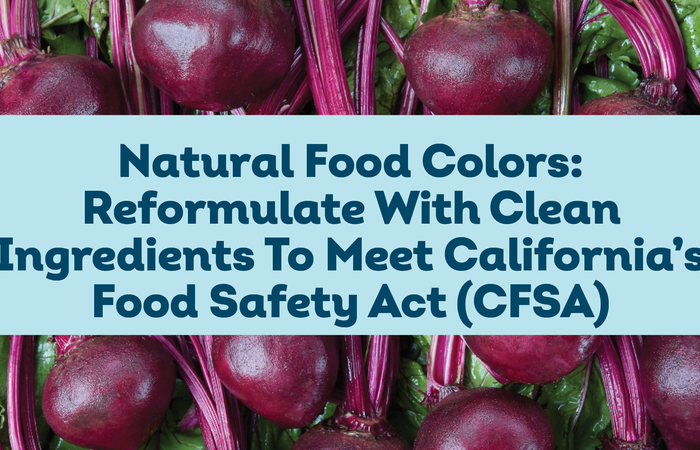
Natural Food Colors: Reformulate With Clean Ingredients To Meet California’s Food Safety Act (CFSA)
The food industry is starting to respond to the requirements of the California Food Safety Act (CFSA) which was signed into law on October 7, 2023. This legislation has banned several ingredients in packaged foods, sparking reformulations for products that are known and loved by consumers. Among the banned products are Brominated Vegetable Oil (BVO), Potassium Bromate, Propylene Glycol, parabens such as Methylparaben and Propylparaben, and Red Dye No. 3. Food brands that use any of these ingredients need a plan for finding natural replacements. This article focuses on the requirement to eliminate Red Dye No. 3 which the FDA banned from cosmetics and topical drugs in 1990.
The act prohibits the manufacture, sale and distribution of products that contain these ingredients in California, effective January 1, 2027. Given the time required for thoughtful reformulation, reformulation will need to commence during 2025 if it hasn’t already begun.
Your Partner in Healthy Reformulation
Reformulation is not a simple process. Not only does it take expertise to perfect the flavor, texture, and the look of the product with new, health-forward ingredients—but the whole process of reformulation requires careful, experienced decision making about product quality and consumer expectations. Unlike new product development, consumers have a clear idea of what they are expecting from existing products. This leaves little room for sub-par product performance.
This kind of challenge can only be met by a team with decades of know-how substituting artificial ingredients with natural ones. No team has more experience—and more success—than the Culinologists at CuliNEX.
A Range of Resources
“We're helping brands re-formulate in terms of forward thinking and future-proofing the brand,” said Mark Crowell, CEO of CuliNEX. “The team at CuliNEX is unmatched in our reformulating capabilities. We were founded on the principle of clean label foods 20 years ago, before it was even a trend. That is all we have ever done.”
At CuliNEX, we utilize a range of resources, ingredients and methods to innovate in the natural color space. We carry over our learnings from each project to save time and resources in our next reformulation. Because we work across every product category, that gives us a depth of experience no one can match.
An Experienced Partner for Substitute Colors
It’s possible to substitute colors using natural ingredients, such as beet juice or turmeric. However, without experience in this area, it can be time-consuming and expensive to successfully replicate the intense, bright hues that consumers have become accustomed to. If you’re trying to achieve a bright orange color for, say, a cheese flavored snack food, or a bright red for a cherry flavored candy, natural ingredients may not achieve the same vibrancy as an artificial dye.
These complications make the reformulation process seem daunting. But when you partner with CuliNEX, you’ve got an experienced partner on your side. Updating formulations is one of our specialties at CuliNEX.
Healthy Reformulation Using Vegetable Colors
Let’s take a closer look at beet juice to achieve a red color in food that needs to be cooked, such as meat products or cereals. The heat of cooking naturally degrades red colors, and beet juice simply does not hold up to the heat of cooking quite as well as artificial dyes.
When this happens, a food producer needs to make some difficult, yet important decisions. Do you accept a product reformulated with a natural dye that doesn't look quite the way it once did? Is the naturally updated product close enough to the original appearance, or will it be so different from what the consumer is accustomed to that they’ll be disappointed by the change? And what type of consumer validation might be useful to help guide reformulation efforts so they meet expectations?
All of these decisions require trade-offs when considering next steps. It’s not just about selecting the right color for the specific application at the optimal level. It’s also about when and where to add it into the formulation. Natural red colors are often heat and pH liable. Sometimes a change to processing steps or the pH of the formulation can be part of optimizing the solution. At CuliNEX, we understand that product development, particularly reformulation, requires deep experience as well as creative problem solving.
More Than Color—Consider Texture, Taste, and Cost
Let’s say a client needs to find alternatives for a green color. The natural substitute could come from spinach powder or another green vegetable or algae. Which one to use? CUliNEX has the experience to understand which ingredient would be ideal, not just for its color, but for its other qualities, such as its fiber content or carbohydrate makeup.
At CuliNEX an ingredient like spinach powder is never just a color derivative. It’s an important ingredient that contributes to the overall texture, mouth feel, and nutrition of a food. When that happens, different regulatory rules come into play. That is another aspect of reformulation that needs to be considered.
“We're looking at things like texture and flavor, but also cost,” said Crowell, “all of that, as well as its functional purpose, such as coloring, is important.” To succeed with efficiency requires a partner like CuliNEX with decades of experience in the natural food space.
Reformulate with CuliNEX
Are you ready to innovate your next product with natural colors? Contact us at CuliNEX to learn how our expertise can streamline your reformulation process and bring you into compliance with the new CFSA without sacrificing hard earned loyalty to your products.








